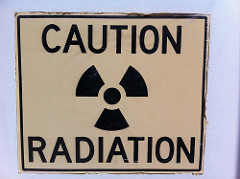If you’ve ever watched The Simpsons, you may be familiar with the explosions that generally result from nuclear meltdowns, likely finding it humorous. Unfortunately, nuclear meltdowns don’t just occur in cartoons and they certainly are not a laughing matter; some notable occurrences include Fukushima, Chernobyl, and Three Mile Island. A nuclear meltdown often occurs when a nuclear reactor core overheats. Although understanding the cause of nuclear meltdowns is essential to preventing them from occurring, a major issue of equal interest is how to treat those affected by the resulting exposure to radiation that can lead to severe health problems. Although some drugs have been developed to protect against radiation before being exposed to it, there currently is no effective treatment for people who have already been exposed. Fortunately, a recent discovery may change that.
Image source: Donald Gruener
Researchers have found that a drug called DBIBB may be capable of treating people who have already been exposed to radiation. In their previous study, they learned that a molecule called lysophosphatidic acid (LPA) activates the LPA2 receptor in order to prevent cells from dying from radiation exposure. The researchers built upon that information by developing a compound that specifically targeted the LPA2 receptor. This compound, called DBIBB, was used to treat mice that had been exposed to radiation three days earlier. The results were that the radiation-exposed blood and intestinal cells were protected from cell death. The study also found that 93% of radiation-exposed mice treated with DBIBB remained alive a month later while only 20% of the untreated mice survived.
The development of DBIBB is a major advancement towards finding an effective treatment for acute radiation syndrome (ARS). The threat of nuclear warfare and the usage of nuclear power has made finding such treatment necessary. Without treatment, people exposed to high dosages of radiation have a very small chance of surviving. The applications of DBIBB can also be extended to other situations where radiation exposure is involved, such as in radiation therapy for cancer.
Feature Image Source: radiation by John Jones










